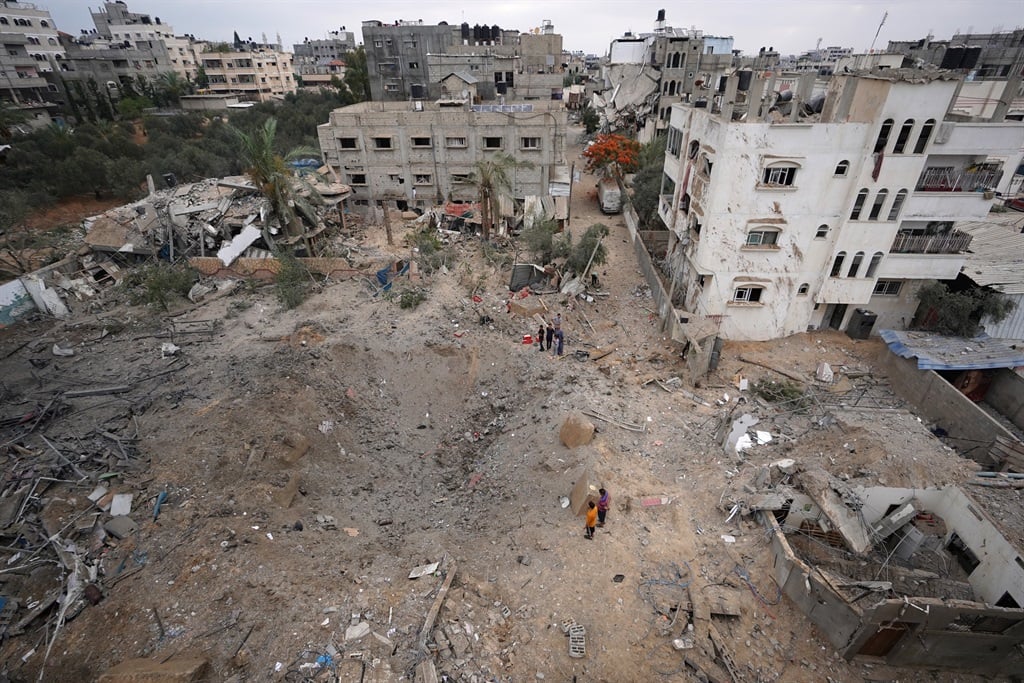Palestinians inspect the damage after an Israeli strike in Nuseirat, in the central Gaza Strip, on 3 June 2024, amid the ongoing conflict between Israel and the Palestinian Hamas militant group. (Bashar Taleb / AFP)
- The Israeli military conducted a strike on a UN school in Gaza, claiming
it was a Hamas compound, resulting in the death of at least 27 people. - Hamas labelled the attack a “horrific massacre… that
shames humanity”. - Tensions in the region have escalated, with violence affecting not just
Gaza but also sparking confrontations between Israel and Hezbollah along the
Lebanon border.
The Israeli
military said Thursday it had carried out a deadly strike on a UN school in
Gaza that it said housed a Hamas compound, with the militant group saying the
attack killed at least 27 people.
The
military said it “eliminated” several “terrorists” after
its jets “conducted a precise strike on a Hamas compound embedded inside
an UNRWA school in the area of Nuseirat”, in central Gaza. UNRWA is the UN
agency for Palestinian refugees.
Hamas’s
media office said the strike killed at least 27 people and wounded dozens more,
calling it a “horrific massacre… that shames humanity”.
Gaza’s bloodiest-ever
war was sparked by Hamas’s 7 October attack on southern Israel, which resulted
in the deaths of 1 194 people, mostly civilians, according to an AFP tally
based on Israeli official figures.
Militants
also took 251 hostages, 120 of whom remain in Gaza, including 41 the army says
are dead.
FOLLOW LIVE | DEVELOPING: No pause in fighting for negotiations, says Israel
Israel’s
ensuing bombardment and ground offensive have killed at least 36 586 people in
Gaza, also mostly civilians, according to the Hamas-run territory’s health
ministry.
Israel has
faced growing diplomatic isolation over its conduct of the war, with cases
against it before two international courts and several European governments
recognising a Palestinian state.
Israel has
frequently accused Hamas and its allies in Gaza of using schools, health
facilities and other civilian infrastructure as operational centres – charges
the militants deny.
UNRWA,
which coordinates nearly all aid to Gaza, has been in crisis since January,
when Israel accused about a dozen of its 13 000 employees in the territory of
being involved in the 7 October attack.
Its chief,
Philippe Lazzarini, said last week that Israel “must stop its campaign
against UNRWA” in an opinion article published by the New York Times.
Sticking points
The latest
strike came as US, Qatari and Egyptian mediators resumed talks Wednesday to try
to secure a truce and hostage release deal.
US
President Joe Biden last week outlined what he called a three-phase Israeli
plan to halt the fighting for six weeks while hostages held by militants in
Gaza are exchanged for Palestinian prisoners and aid is stepped up.
G7 powers
and Arab states have backed the proposal announced by Biden, although sticking
points remain — Hamas insists on a permanent truce and full Israeli
withdrawal, demands that Israel has flatly rejected.
READ | Gaza at risk of diseases this summer from piled-up waste, NGO warns
A source
with knowledge of the negotiations confirmed to AFP that a meeting took place
on Wednesday “between the Qatari prime minister and head of Egyptian
intelligence with Hamas in Qatari capital Doha to discuss a deal for a truce in
Gaza and the exchange of hostages and prisoners”.
Biden has
urged Hamas to accept the deal and has deployed CIA chief Bill Burns to Qatar,
where the group’s political bureau is based, for a renewed push after months of
negotiations.
The source
said Burns would “continue working with mediators on reaching an agreement
between Hamas and Israel on a ceasefire in Gaza and the release of
hostages”.
Biden
earlier told Qatar’s emir that “Hamas is now the only obstacle to a
complete ceasefire”, and “confirmed Israel’s readiness to move
forward” with the terms he set out last week.
A senior
Hamas official in Beirut on Tuesday accused Israel of seeking
“endless” negotiations and reiterated the group’s position rejecting
any deal that excludes a permanent ceasefire.
Hamas
leader Ismail Haniyeh said his group would “deal seriously and
positively” with any offer meeting those demands.
Muhammad
al-Najjar, a 35-year-old man from northern Gaza twice displaced by the war,
told AFP: “We just want to solve and end the catastrophic situation that
we are living. What matters to us is that the war made us exhausted, destroyed
us and destroyed everything in our lives.”
Jerusalem march
In
Jerusalem, Israeli police deployed 3 000 officers ahead of the annual march by
right-wingers commemorating Israel’s capture of the Old City in the 1967
Arab-Israeli war.
The march
draws Israeli religious ultranationalists and Zionist youth groups and leads
through the city’s Muslim Quarter to the Western Wall. It has been a lightning
rod for Israeli-Palestinian tensions in recent years.
READ | ‘Jerusalem is ours’: Thousands of Israel nationalists march on flashpoint Jerusalem Day
Tensions
have also spiralled elsewhere in the region between Israel and its allies on
the one hand, and Iran-backed armed groups in Lebanon, Iraq, Syria and Yemen on
the other.
The Israeli
army and Lebanon’s Hezbollah movement have traded near-daily cross-border fire,
causing deaths, forcing mass evacuations and igniting wildfires on both sides.
Prime
Minister Benjamin Netanyahu said on Wednesday that Israel was “prepared
for a very intense operation” along the border with Lebanon and that
“one way or another, we will restore security to the north”.
The United
States appeared to warn Israel against taking action on Wednesday, with the
State Department saying that any “escalation” there would risk
Israeli security.
The
violence since early October has killed at least 455 people in Lebanon, mostly
fighters but including 88 civilians, according to an AFP tally.
On the
Israeli side, the army says at least 14 soldiers and 11 civilians have been
killed.





















Discussion about this post